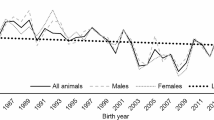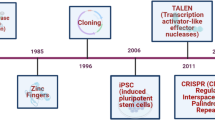Abstract
The present study was conducted to identify the polymorphism of estrogen receptor (ESR) gene and its biological association with litter traits (litter size at birth, litter size at weaning, litter weight at birth and litter weight at weaning) of Doom pigs native to Assam. A total of 50 adult pigs (12 males and 38 females) chosen randomly from three different herds (Herd I, Herd II, and Herd III) were utilized in the present study. Detection of polymorphism of ESR gene was done by means of PCR-RFLP method. The amplified PCR product was digested with Pvu II restriction enzyme. PCR-RFLP analysis of ESR gene revealed polymorphic banding pattern. Two genotypes viz. AA and AB were identified. AA genotype yielded one fragment (120 bp) and AB genotype yielded three fragments (120, 65, and 55 bp). BB genotype was not found in the population under study. The frequencies of A and B alleles were found to be 0.650 and 0.350, respectively, and the genotypic frequencies of ESR gene were found to be 0.300 and 0.700 for AA and AB genotypes, respectively. There was no significant (P > 0.05) effect of ESR genotype on litter traits and the population under study was not in Hardy-Weinberg Equilibrium for ESR gene. Clustal W Multiple alignment of partial sequence of ESR gene revealed single nucleotide changes at 33, 65, 70, 83, and 92nd nucleotide positions. The presence of Pvu II polymorphism and identification of single nucleotide variation of ESR gene opens interesting prospects for improvement of litter traits in Doom pig through selective breeding program, especially based on marker-assisted selection.



Similar content being viewed by others
Abbreviations
- ESR:
-
estrogen receptor
- DNA:
-
deoxyribonucleic Acid
- EDTA:
-
ethylenediamine tetraacetic acid
- PCR:
-
polymerase chain reaction
- RFLP:
-
restriction fragment length polymorphism
- SDS:
-
sodium dodecyl sulfate
- OD:
-
optical density
- DMRT:
-
Duncan’s multiple range test
- Bp:
-
base pair
- SNP:
-
single nucleotide polymorphism
- LSM:
-
least squares mean
Bibliography
Bagi, A. H., Balogh, P., Nagy, K., Kusza, S., 2016. Association and polymorphism study of seven candidate genes with reproductive traits in three pig breeds in Hungary. Acta Biochimical Polonica, 63 (2), 359-364.
Balatsky, V. N., Saenko, A. M., Grishina, L. P., 2012. Polymorphism of the estrogen receptor 1 locus in populations of pigs of different genotypes and its association with reproductive traits of large white sows. Cytology and Genetics, 46(4), 233-237.
Banik, S., Naskar, S., Zaman, G., Sarma, D. K., Tamuly, M. K., Gandhi, R. S., 2016. Doom Pig, An Indigenous Pig Germplasm of Assam. ICAR-National Research Centre on Pig, Rani, Guwahati.
Chen, Z., Ye, S., Teng, J., Diao, S., Yuan, X., Chen, Z., Zhang, H., Li, J., Zhang, Z., 2019. Genome-wide association studies for the number of animals born alive and dead in duroc pigs. Theriogenology, 139, 36-42.
Dall’Olio, S., Fontanesi, L., Buttazzoni, L., Gallo, M., Russo, V., 2011. ESR 1 and ESR 2 gene markers are not associated with number of piglets born alive in Italian Large White Sows. Italian Journal of Animal Science, 10(3), 185-188.
Drogemuller, C., Hamann, H., Distl, O. 2001. Candidate gene markers for litter size in different German pig lines. Journal of Animal Science, 79, 2565-2570.
Falconer, D. S., Mackay, T. F. C., 1996. Introduction to Quantitative Genetics, 4th Edition, Pearson Publication.
Feldpausch, J.A., Jourquin, J., Bergstrom, J. R., Bargen, J. L., Bokenkroger, C. D., Davis, D.L., Gonzalez, J. M., Nelssen, J. L., Puls, C.L., Trout, W.E., Ritter, M. J., 2019. Birth weight threshold for identifying piglet at risk for preweaning mortality. Translational Animal Science, 3(2), 633–640.
Flores, C. L., Martinez, K. M., Rodriguez-Carpena, J. G., 2009. Genetic diversity and variation of ESR, RBP4 and FUT1 genes in Mexican Creole and Yorkshire pig populations. Journal of Biological Sciences, 9(8), 878-883.
Goliasova, E., Dvorak, J., 2005. The oestrogen receptor gene (ESR) Pvu II polymorphism genotype and allele frequencies in Czech Large White and Landrace. Acta Universitatis Agriculturaeet Silviculturae Mendelianae Brunensis, III (2), 33-38.
Johari, M., Saharia, K. K., Bora, L., Roychoudhury, R., Khuman, L.S., Talukdar, J., 2014. Problems faced by pig farmers in Dima Hasao District of Assam. Journal of Krishi Vigyan, 2(2), 59-63.
Kabalin E.A., Starčević K., Menčik S., Maurić M., Sušić V., Štoković I., 2013. Analysis of ESR and RBP polymorphisms in black Slavonian sows: preliminary results. Acta Argiculturae Slovenica, Supplement 4, 45–48,
Kmiec, M., Drovak, J., Vrtkova, I., 2002. Study on a relation between estrogen receptor (ESR) gene polymorphism and some pig reproduction performance characters in Polish Landrace breed. Czech Journal of Animal Science, 47(5), 1212-1819.
Laliotis, G. P., Marantidis, A., Avdi, M., 2015. Relation between ESR 2 genotypes and reproductive performance of a Large White x Landrace sow population. International Journal of Biological Sciences and Applications, 2(6), 67-70.
Legault, C., Gruand, J., Lebost, J., Garreau, H., Ollivier, L., Messer, L. A., Rothschild, M. F. 1996. Fréquenceeteffetsur la prolificité du gčne ESR dansdeuxlignées Large White en France. Journées de la Recherche Porcine en France, 28, 9-14.
Linville, R. C., Pomp, D., Johnson, R. K., Rothschild, M. F., 2001. Candidate gene analysis for loci affecting litter size and ovulation rate in swine. Journal of Animal Science, 79(1), 60-67.
Matoušek V., Kernerová N., Kolaříková O., Křížová H., Urban T., Vrtková I., 2003. Effect of RYR1and ESR genotypes on the fertility of sows of Large White breed in elite herds. Czech Journal of Animal Science., 48, 129–133.
Mencik, S., Vukovic, V., Spehar, M., Modric, M., Ostovic, M., Ekert, K. A. 2019. Association between ESR1 and RBP4 genes and litter size traits in a hyperprolific line of Landrace x Large White cross sows. Veterinarni Medicina, 64, 109–117.
Muñoz, G., Ovilo, C., Estellé, J., Silió, L., Fernández, A., Rodriguez, C., 2007. Association with litter size of new polymorphisms on ESR1 and ESR2 genes in a Chinese-European pig line. Genetics Selection Evolution, 39 (2), 195-206.
Rahman, M., Phookan, A., Zaman, G. U., Das, A., Akhtar, F., Hussain, J., Choudhury, H., 2020a. Growth and reproductive performances of doom pigs under field condition. Veterinary Research International, 08(2), 73-77.
Rahman, M., Phookan, A., Zaman, G. U., Ahmed, S.I., Deori, S., Hoque, E., 2020b. Performance of Doom pigs under different production systems in subtropical ecosystem of north east India. Indian Journal of Animal Sciences, 90 (2), 292–295.
Rathje, T.A., Rohrer, G. A., Johnson, R. K., 1996. Quantitative trait loci affecting reproductive traits in swine. Journal of Animal Science, 74(Suppl. 1), 122(Abstr.).
Rothschild, M. F., Tuggle, C. K., Vaske, D. A., Wang, L., 1995. Development of a consensus map for chromosome 1 in the pig. Journal of Animal Science, 73 (1): 40.
Rothschild, M. F., Jecobson, C., Vaske, D. A., Tuggle, C. K., Wang, L., Short, T. H., Sasaki, S., Vincent, A., Eckardt, G. R., Mileham, A. J., McLaren, D., Plastow, G. S., Southwood, O. I., Van der Steen, H. A. M., 1996. The oestrogen receptor locus is associated with a major gene influencing litter size in the pigs. Proceedings of the National Academy of Sciences, 93, 201-205.
Rydhmer, L., (2000) Genetics of sow reproduction, including puberty, oestrus, pregnancy, farrowing and lactation. Livestock Production Science 66 (1):1–12.
Sambrook, J. F., Russell, D. W., 2001. Molecular Cloning: A Laboratory Manual, 3rdEdn. Cold Spring Harbor, Laboratory Press.
Santana, B.A.A., Fernando, H. B., Robson, C. A., Mauricio, B., Mauricio, M. F., Luiz, R. G. 2006. Association of the estrogen receptor gene Pvu II restriction polymorphism with expected progeny differences for reproductive and performance traits in swine herds in Brazil. Genetics and Molecular Biology, 29 (2), 273-277.
Shankar, B. P., Madhusudhan, H. S., Harish, D. B., 2009. Pre-weaning mortality in pig-causes and management. Veterinary World, 2(6), 236-239.
Short, T. H., Rothschild, M. F., Southwood, O. I., McLarem, D. G.,Vries, A. D., Steen, H. V. D., Eckardt, G. R., Tuggle, C. K., Helm, J., Vaske, D. A., Mileham, A. J., Plastow, G. S., 1997. Effect of the estrogen receptor locus on reproduction and production traits in four commercial pig lines. Journal of Animal Science, 75, 3138-3142.
Smith, A. L., Stalder, K. J.,Serenius, T. V., 2007. Effect of piglet birth weight on weights at weaning and 42 days post weaning. Journal of Swine Health and Production, 15(4), 213–218.
Talukdar, P., Talukdar, D., Sarma, K., Saikia, K., 2020. Prospects and potentiality of improving pig farming in North Eastern Hill Region of India: an overview. International Journal of livestock research, 9(1), 1-14.
Thorpe, W., Jemaneh, T.(eds), 2008. Pig systems in Asia and the Pacific: how can research and development enhance benefits to the poor? Proceedings of a regional workshop held in Bangkok, Thailand, 23-24 November 2006. Nairobi (Kenya): ILRI.
Tomar, S.S., 2004. Textbook of Animal Breeding. Kalyani Publishers, New Delhi, India, pp. 60-61
Acknowledgements
The authors thankfully acknowledge Assam Agricultural University (AAU), Khanpara, Assam, India, for providing the necessary facilities to conduct the research. The authors also acknowledge Molbiogen (Apical Scientific) for their significant contribution in the experiment.
Funding
Assam Agricultural University, Khanapara, India-781022
Author information
Authors and Affiliations
Contributions
MR: Conducted the experiment, AP: Design and guided the experiment, GUZ and AD: Statistical Analysis, FA and ST: Molecular analysis of data, HC and LMS: Helps in data collection, recording and manuscript writing.
Corresponding author
Ethics declarations
Ethics approval and consent to participate
The Research was conducted after getting approval from Institutional Animal Ethics Committee (IEAC), AAU, Khanapara, India-781022 (Approval No. 770/ac/CPCSEA/F.V.Sc./AAU/IEAC/17-18/477).
Conflict of interest
The authors declare that there is no conflict of interest for this study.
Additional information
Publisher’s note
Springer Nature remains neutral with regard to jurisdictional claims in published maps and institutional affiliations.
Rights and permissions
About this article
Cite this article
Rahman, M., Phookan, A., Zaman, G.U. et al. Allelic variability of estrogen receptor (ESR) gene and its effect on litter traits of Doom pigs. Trop Anim Health Prod 53, 316 (2021). https://doi.org/10.1007/s11250-021-02756-6
Received:
Accepted:
Published:
DOI: https://doi.org/10.1007/s11250-021-02756-6




